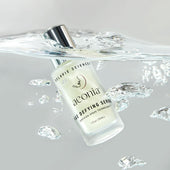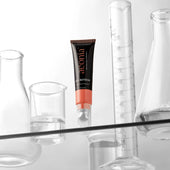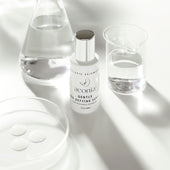Visioscan® Surface Evaluation Clinical Study
1.0 OBJECTIVE
The purpose of this study was to evaluate the efficacy of an age-defying serum when used twice-daily and tested over a 28-day period under ambient conditions. Effectiveness of the test product was evaluated objectively on a group of 35 subjects. Surface evaluation of living skin (SELS) was conducted instrumentally using a Visioscan® image analysis system.
2.0 SURFACE EVALUATION OF LIVING SKIN VIA VISIOSCAN®
(WRINKLES [SEW] AND SKIN SURFACE SMOOTHNESS [SESM]) RESULTS:
Surface Evaluation of Living Skin (SELS) has shown the test material reduced the average number, width and depth of fine lines and wrinkles and improved skin surface smoothness. Visioscan® measurements uncovered a statistically significant reduction in SEw parameter calculated from the proportion of horizontal and vertical wrinkles at all evaluation time points with the maximum average reduction of 16.83% after 28 days.
Moreover, calculation of the average depth and width of wrinkles concluded the test material improved skin smoothness as indicated by reduction in SEsm parameter. The decrease in SEsm is considered statistically significant after 28 days.
Visioscan® images were collected for each subject at each time point. Typical examples of before and after Visioscan® can be seen below.




3.0. TEST MATERIAL EVALUATION PRE-REQUISITE:
Prior to induction of a human test panel, toxicology, microbiology, or in-vitro performance spectra may be required to assess the feasibility of commencement as dictated by an Institutional Review Board (IRB).
3.1.1
Sponsor purports that prior to sample submission, test materials were approved by the Sponsor’s Legal and Regulatory departments for inclusion in this testing program, and that the following tests were conducted with no adverse results and the test data are on file at their premises and have not been made available to personnel:
- USP or CTFA Preservative Efficacy Test or equivalent
- 90 Day Accelerated Stability and Container Compatibility Study
- Fifty (50) person Repeat Insult Patch Test (RIPT) or equivalent
4.0 INSTITUTIONAL REVIEW BOARD [IORG0011153] [IRB00013226]:
Reference: CFR Title 21 Part 56, Subparts A, B, C, and D. The IRB consists of 5 or more individuals, chosen for technical expertise and from the local community for lay interaction. The list of IRB members is kept on file and is available for inspection during regular hours of operation.
5.0 PANEL SELECTION:
5.1. KEY STANDARDS FOR INCLUSION IN THE STUDY:
a. Females between 35 and 70 years old of varying ethnicities (skin types: all, I through VI).
b. Individuals, who read, understood, and signed an informed consent document as required by CFR Title 21, Part 50, Subpart B regulations.
c. Individuals who have abstained from using any anti-aging, sun-protecting and moisturizing products, including lotions, creams, and gels during the 7-day washout period and the entire duration of the study.
d. Individuals who agreed to use only the assigned test product during the test period.
5.2. KEY STANDARDS FOR EXCLUSION FROM THE STUDY:
a. Individuals who are under the care of a physician for conditions that would interfere with the test results, at the discretion of the Study Director.
b. Individuals currently taking medication that may mask or interfere with the test results, including the use of any anti-acne drugs, topical and oral retinoids, topical antibacterial agents, and any immunosuppressive drugs.
c. Individuals known to be participating in other clinical studies.
d. Individuals known to be employees of testing firms/laboratories or cosmetic/raw materials suppliers.
5.3. RECRUITMENT:
Panel selection is accomplished by advertisements in local periodicals, community bulletin boards, phone solicitation, electronic media, or any combination thereof.
6.0 PANEL DEMOGRAPHICS:
Thirty-five (35) subjects were selected for this study:
Number of subjects enrolled ............................................................................... 35
Number of subjects completing study ................................................................. 34
Age Range ...................................................................................................... 45 - 69
Sex .................................................................... Female ..................................... 34
7.0 PROCEDURE:
A seven-day (7) washout phase was required prior to study commencement. During this phase, the daily wash procedure was standardized in all subjects. Participants were instructed to use only lab-issued soap. Additionally, as a condition of enrollment, only the subjects who abstained from using anti-aging, sun-protecting or moisturizing products throughout the entire study period including the washout phase were recruited for participation.
On the initial day of the study, upon arrival at the testing facility, subjects were required to familiarize themselves with, then sign an informed consent. Panelists were mandated to adhere to all the restrictions mentioned in the inclusion/exclusion sections. All participants were advised of the general nature and purpose of this study. The subjects were then acclimated to the ambient environment for a period not less than fifteen (15) minutes prior to baseline evaluation and biophysical measurements. The acclimation procedure was repeated for each subsequent evaluation time point
The study was conducted according to Sponsor’s requested design wherein all subjects received written and verbal instructions regarding product use and study restrictions. Subjects were required to use the test material as a part of their daily routine according to the following sponsor supplied instructions:
“Apply one (1) pre-primed drop of the serum morning and evening. To apply, twist the cap and watch the pre-primed pump in action. Remove the cap and press down to release the perfect amount. Rub into hands and gently apply onto the face.”
Each product was weighed and recorded on a Product Weight Log prior to study initiation and again upon study completion to establish a use determination.
The Visioscan (Courage and Khazaka) takes a direct image of the living skin using a measuring head containing a CCD-camera and two metal halogen lamps positioned opposite each other to ensure even illumination of the measuring field on the skin. The grey level distribution of the pixels in the image correspond to different phenomena (white pixels represent desquamation on the skin, dark pixels represent lines and wrinkles). The software with the Visioscan automatically calculates skin smoothness, skin roughness, scaliness and wrinkle parameters.
8.0 REFERENCES:
Fischer, T.W., Wigger-Alberti W., Elsner P., Direct and non- direct measurement techniques for analysis of skin surface topography. Skin Pharmacol Appl Skin Physiol 1999; 12:1-11.
Mike Farwick, Ursula Maczkiewitz, Peter Lersch, Tim Falla, Susanne Grether-Beck, Jean Krutmann; An EC-derived Tetrapeptide to Counterbalance ECM Degeneration; Cosmetic & Toiletries magazine, Vol 124 Np. 6/June 2009.








